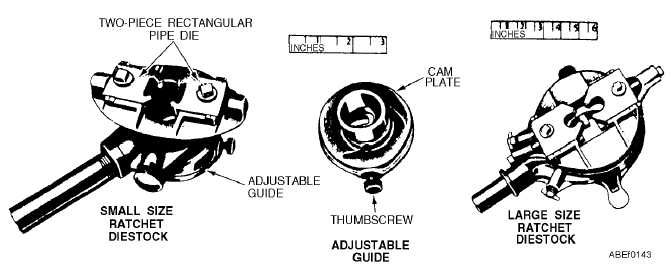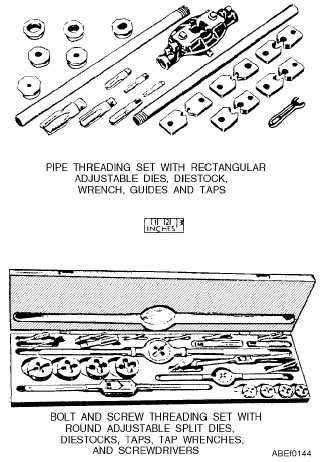guide, which screws into the underside of the cap. The
die is adjusted by setscrews at both ends of the interval
slot. This type of adjustable die is issued in various
sizes to cover the cutting ranges of American Standard
Coarse and Fine and special-form threads. Diestocks to
hold the dies come in three different sizes.
Two-piece rectangular pipe dies (fig. 1-55) are
available to cut American Standard Pipe threads. They
are held in ordinary or ratchet-type diestocks (fig.
1-57).
Threading sets are available in many different
combinations of taps and dies, together with diestocks,
tap wrenches, guides, and necessary screwdrivers and
wrenches to loosen and tighten adjusting screws and
bolts. Figure 1-58 illustrates typical threading sets for
pipe, bolts, and screws.
Never attempt to sharpen taps or dies. Sharpening
of taps and dies involves several highly precise cutting
processes that involve the thread characteristics and
chamfer. These sharpening procedures must be done by
experienced personnel to maintain the accuracy and the
cutting effectiveness of taps and dies.
Keep taps and dies clean and well oiled when not in
use. Store them so that they do not contact each other or
other tools. For long periods of storage, coat taps and
dies with a rust-preventive compound, place in
individual or standard threading set boxes, and store in
a dry place.
REVIEW QUESTIONS
Q25.
Identify the different types of taps.
Q26.
What are taper taps used for?
Q27.
Identify the different types of dies.
Q28.
What are two-piece rectangular pipe dies
used for?
1-36
Figure 1-57.—Adjustable die guide and ratchet diestocks.
Figure 1-58.—Tap and die thread sets.



